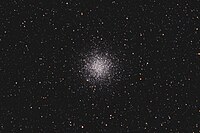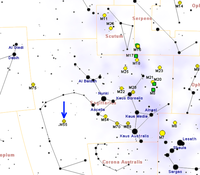| Messier 55 | |
|---|---|
 Globular cluster Messier 55 in Sagittarius Globular cluster Messier 55 in Sagittarius | |
| Observation data (J2000 epoch) | |
| Class | XI |
| Constellation | Sagittarius |
| Right ascension | 19 39 59.71 |
| Declination | −30° 57′ 53.1″ |
| Distance | 17.6 kly (5.4 kpc) |
| Apparent magnitude (V) | 6.3 |
| Apparent dimensions (V) | 19.0′ |
| Physical characteristics | |
| Mass | 2.69×10 M☉ |
| Radius | 48 ly |
| Metallicity | = –1.94 dex |
| Estimated age | 12.3 Gyr |
| Other designations | M55, NGC 6809, GCl 113, C 1936-310 |
| See also: Globular cluster, List of globular clusters | |
Messier 55 (also known as M55, NGC 6809, or Specter Cluster) is a globular cluster in the south of the constellation Sagittarius. It was discovered by Nicolas Louis de Lacaille in 1752 while observing from what today is South Africa. Starting in 1754, Charles Messier made several attempts to find this object from Paris but its low declination meant from there it rises daily very little above the horizon, hampering observation. He observed and catalogued it in 1778. The cluster can be seen with 50 mm binoculars; resolving individual stars needs a medium-sized telescope.
It is about 17,600 light-years away from Earth. It contains about 269,000 solar masses (M☉). As with other Milky Way globular clusters, it has few elements other than hydrogen and helium compared to the Sun. Messier 55 therefore has "low metallicity". This quantity is normally listed as the base 10 logarithm of the proportion of the Sun; for NGC 6809 the metallicity is given by: = −1.94 dex, whereby −2 would be 100 times less iron than the Sun. This means the cluster has 1.1% of the proportion of the Sun's iron compared to hydrogen and helium.
Only about 55 variable stars have been found in the central part of M55.
Gallery
See also
References and footnotes
- Shapley, Harlow; Sawyer, Helen B. (August 1927), "A Classification of Globular Clusters", Harvard College Observatory Bulletin, 849 (849): 11–14, Bibcode:1927BHarO.849...11S.
- ^ Goldsbury, Ryan; et al. (December 2010), "The ACS Survey of Galactic Globular Clusters. X. New Determinations of Centers for 65 Clusters", The Astronomical Journal, 140 (6): 1830–1837, arXiv:1008.2755, Bibcode:2010AJ....140.1830G, doi:10.1088/0004-6256/140/6/1830, S2CID 119183070
- ^ Boyles, J.; et al. (November 2011), "Young Radio Pulsars in Galactic Globular Clusters", The Astrophysical Journal, 742 (1): 51, arXiv:1108.4402, Bibcode:2011ApJ...742...51B, doi:10.1088/0004-637X/742/1/51, S2CID 118649860
- "Messier 55". SEDS Messier Catalog. Retrieved April 29, 2022.
- From trigonometry: radius = distance × sin( diameter_angle / 2 ) = 17,600 × sin(19′/2) = 48.6 ly.
- Sollima, A.; et al. (April 2008), "The correlation between blue straggler and binary fractions in the core of Galactic globular clusters", Astronomy and Astrophysics, 481 (3): 701–704, arXiv:0801.4511, Bibcode:2008A&A...481..701S, doi:10.1051/0004-6361:20079082, S2CID 3088769
- "M 55". SIMBAD. Centre de données astronomiques de Strasbourg. Retrieved November 16, 2006.
- ^ Thompson, Robert Bruce; Thompson, Barbara Fritchman (2007), Illustrated guide to astronomical wonders, DIY science, O'Reilly Media, Inc., p. 413, ISBN 978-0-596-52685-6
- Kaluzny, J.; et al. (September 2010), "The Cluster AgeS Experiment (CASE). Variable Stars in the Globular Cluster M55", Acta Astronomica, 60 (3): 245–260, arXiv:1011.0831, Bibcode:2010AcA....60..245K
- On June 16th
- Specifically in the south of this constellation which makes it visible from everywhere below about the 50th parallel north. However the Sun passes through Sagittarius (or technically the Earth orbits so as to make the Sun seem to do so) throughout December. This also makes the cluster mostly risen during day, not night, in the nearest months.
External links
- Messier 55, SEDS Messier pages
- Messier 55, Galactic Globular Clusters Database page
- NASA Astronomy Picture of the Day: M55 Color Magnitude Diagram (23 February 2001)
- Messier 55 on WikiSky: DSS2, SDSS, GALEX, IRAS, Hydrogen α, X-Ray, Astrophoto, Sky Map, Articles and images
| Messier objects | ||
|---|---|---|
| List |
|  |
| See also | ||
| Astronomical catalogs | |
|---|---|
| Messier | |
| NGC | |
| New General Catalogue 6500 to 6999 | |
|---|---|
| |
 = –1.94
= –1.94 
